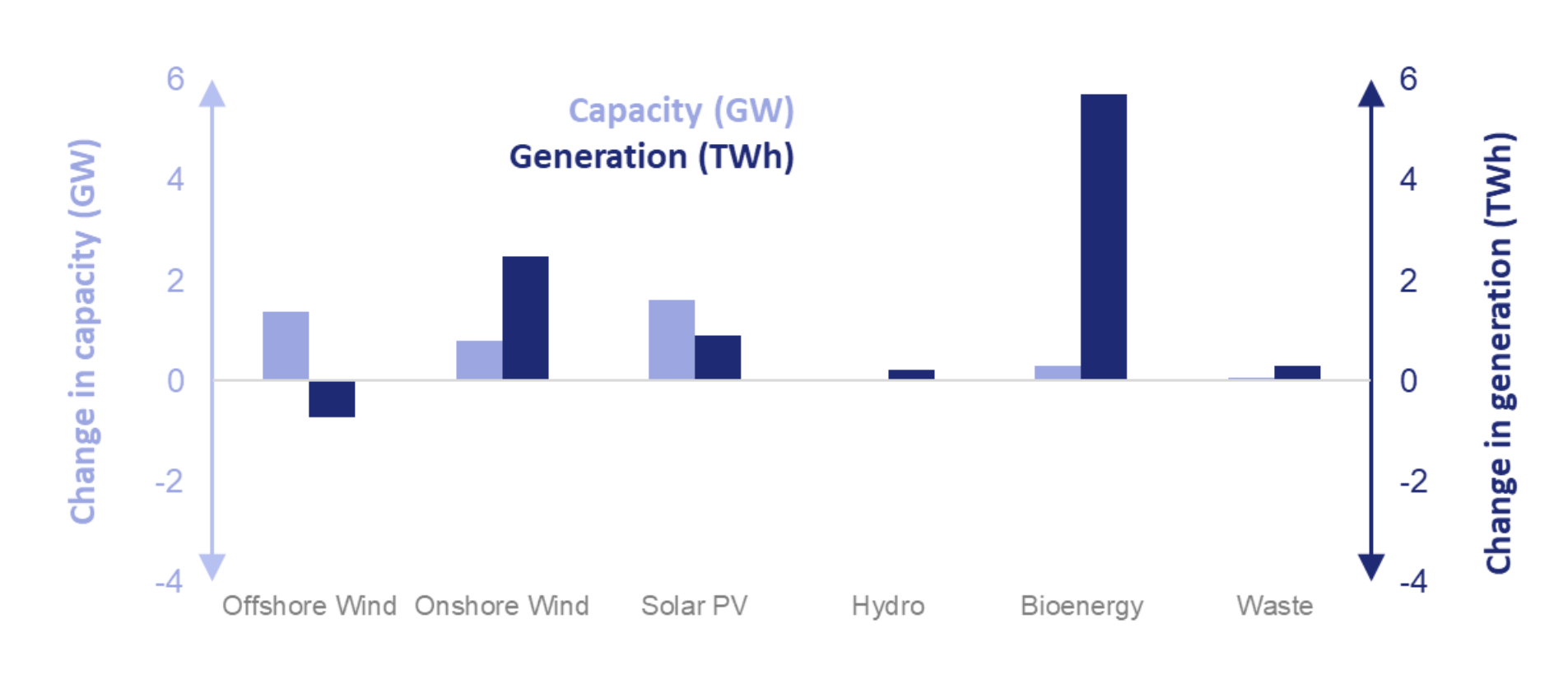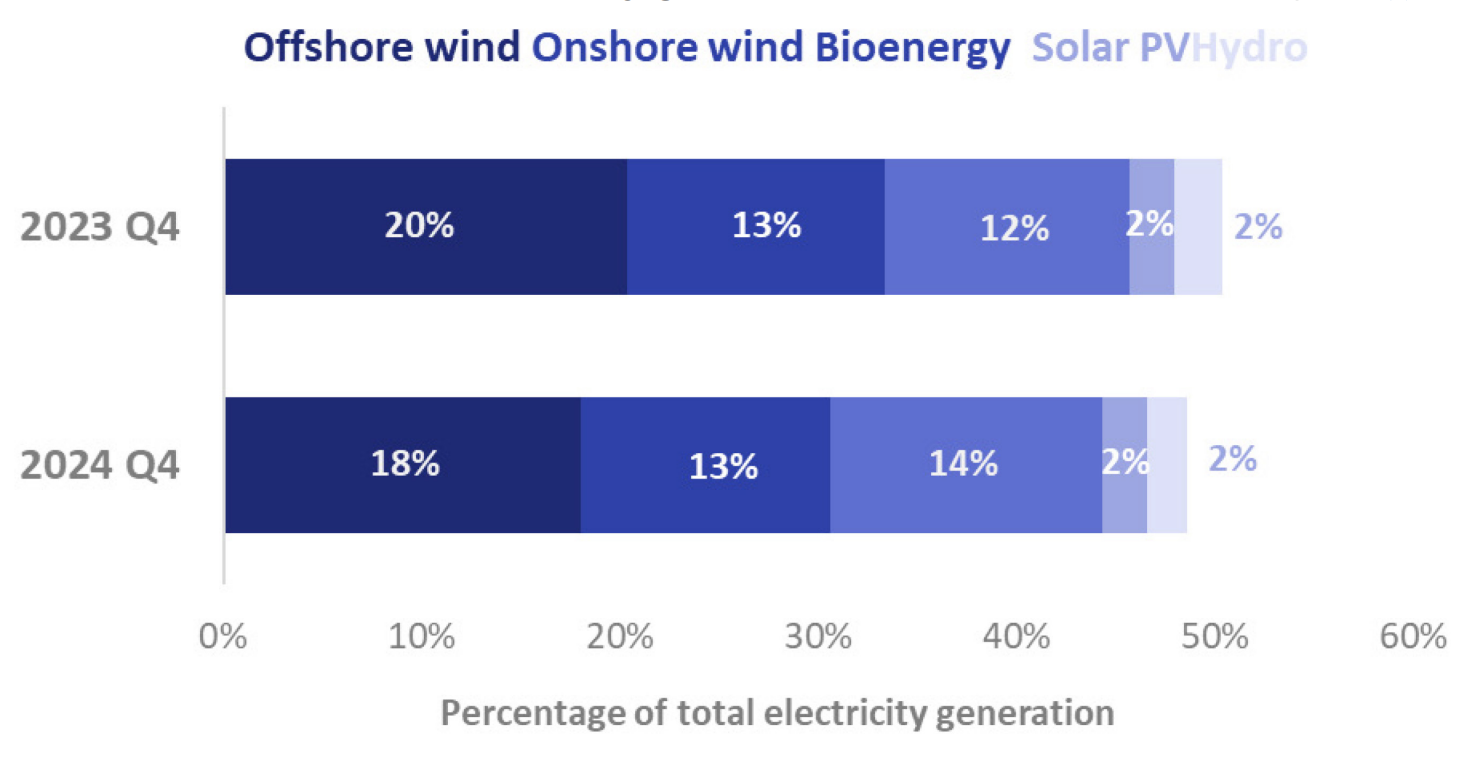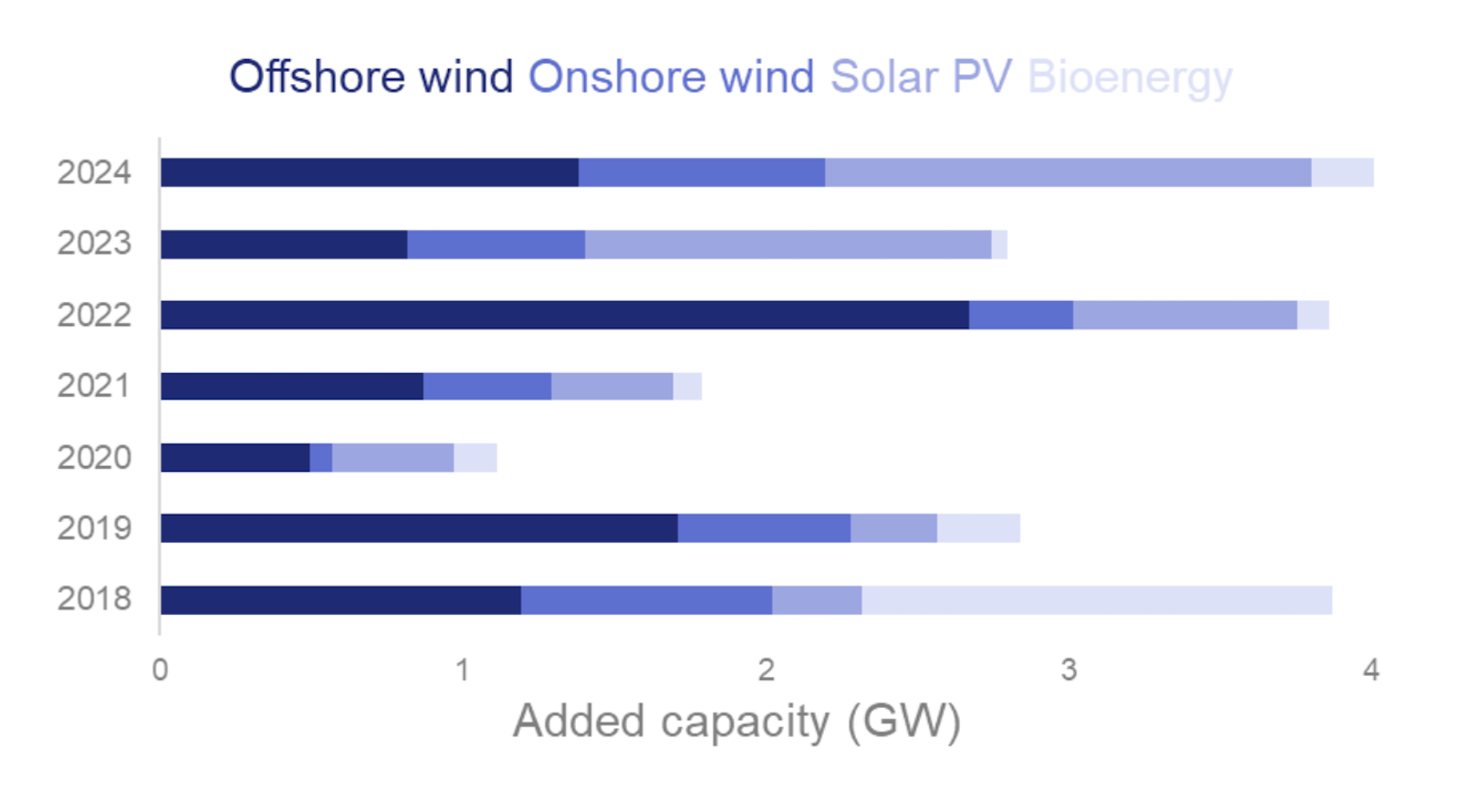Sign up for daily news updates from CleanTechnica on email. Or follow us on Google News!
Last Updated on: 29th March 2025, 02:22 am
Key headlines
Renewable generation was a record 144.7 TWh in 2024, up 6.5 per cent from 2023, with new capacity more than offsetting less favourable weather conditions. Increased generation was driven by record levels of generation from bioenergy, wind, and solar PV.
Renewable’s share of electricity generation was 50.8 per cent in 2024, the first time that more than half of generation has come from renewables. This was the result of growth in renewable generation and a fall in nonrenewable generation.
A total 4.2 GW of capacity was added taking the total installed capacity to 60.7 GW, up from 9.3 GW in 2010. The new capacity was largely made up of wind (1.4 GW offshore and 0.8 GW onshore) and solar PV (1.6 GW).
Generation for 2024 Quarter 4 was 37.5 TWh, down by 2.6 TWh (6.4 per cent) on 2023 Quarter 4, mainly due to less favourable weather conditions. In particular, offshore wind generation was down by 14 per cent on last year, this was partly down to lower average wind speeds in the South East, curtailment and a fault with a subsea export cable early in the quarter. This fall was partly offset by an increase in plant biomass generation.
Renewables share of generation was 48.6 per cent in 2024 Quarter 4, 1.8 percentage points down on 2023 Quarter 4.
Chart 6.1 Renewable generation from 2018 (Energy Trends Table 6.1)

Since 2018, renewable generation has increased by 31 per cent with offshore wind accounting for almost two thirds of the increase. For the first time, in 2019, offshore generation overtook onshore and the divergence has continued since then. This is largely due to new capacity which saw strong growth from 2017 onwards. Although offshore capacity is still lower than onshore, the gap has closed to just 0.6 percent lower in 2024. It’s ability to outperform onshore wind generation relative to installed capacity is down to newer, larger turbines installed off the coast. Furthermore, wind speeds are often stronger offshore. In 2020, unusually high wind speeds and rainfall resulted in a 12 per cent increase in renewable generation compared to 2019, though the following year weather conditions reversed and in addition, there were unusually low sun hours. Although 17 weather conditions stabilised and new capacity was added (notably in offshore wind), overall renewable generation growth was subdued in 2022 and 2023 largely due to reduced output at two large biomass power plants (output resumed to more usual levels in 2024, see next paragraph for more information). Chart 6.2 shows in more detail the trends between 2023 and 2024.
Chart 6.2 Change in renewable generation and capacity between 2023 and 2024 (Energy Trends Table 6.1)

Most notable this year is the high increase in bioenergy generation, up 18 per cent achieving a record in 2024. Although new capacity contributed to the growth, the sharp increase was mostly due to plant biomass returning to more usual levels following reduced output at two major plants in 2022 and 2023. Although plant biomass remains 1.7 percent lower than in 2021, increased generation from energy from waste and anaerobic digestion facilitated the record for overall bioenergy. The trends in wind generation are different between onshore and offshore wind. Although both saw an increase in capacity, only onshore wind displayed an increase in generation (by 7.6 per cent, compared with a 1.5 per cent decrease in offshore generation). Industry attributes a fault with a subsea export cable, curtailment, and lower wind speeds in the South East as contributory factors to the fall in offshore wind generation. Overall, the increase in onshore wind offset the drop in offshore wind and resulted in a record for overall wind generation.
Solar PV generation also achieved a record with a 9.9 per cent increase in installed capacity more than offsetting fewer sun hours. The 1.6 GW of new capacity was the largest added since 2016. Hydro generation increased by 4.1 per cent despite a slight decrease in rainfall, and no change in capacity.
New capacity added in 2024 was 4.2 GW, the highest since 2017. Since 2020, new offshore wind has represented almost half of the total new installed capacity, with solar PV accounting for 32 per cent and onshore wind, the bulk of the remainder. New capacity for offshore wind included Neart na Gaoithe (NnG) (448 MW) and Moray West (882 MW) in Scotland. Both of these plants came online later in the year so while they have added 1.3 GW of capacity between them, they are yet to have a large impact on generation.
Chart 6.3 Added capacity for the leading technologies (Energy Trends Table 6.1)

In 2024, new wind capacity represented just over half of the total added capacity, a similar share to 2023, with offshore wind accounting for almost two thirds of this. In 2023, new solar PV capacity represented almost half of the total, and although growth in solar PV capacity for the year was strong (9.9 per cent), in 2024 it made up 39 per cent of new capacity. This was in part due to an increase in bioenergy capacity.
Whereas offshore wind sites tend to be few in number but large scale, the growth in solar PV has been dominated by numerous installations of less than 50 kW, including 147,000 new domestic installations in 2024. These figures may be missing some unsubsidised solar installations below 150 kW capacity that are not registered on the Microgeneration Certification Scheme (MCS). For more details see the solar deployment tables (opens in a new window).
In the fourth quarter, 0.8 GW of new capacity was installed, around two thirds of which was accounted for by wind. Solar PV capacity increased by 1.4 per cent, slightly more than Quarter 3 but less than the first two quarters of 2024. There was no new bioenergy capacity in the fourth quarter, for the second quarter in a row. The majority for the year was installed in the first quarter and included Teesside (plant biomass- 250 MW).
Chart 6.4 Renewables’ share of electricity generation — Q4 2023 and Q4 2024 (Energy Trends 6.1)

In 2024 Quarter 4, renewable’s share of generation was 48.6 per cent. This was 1.8 percentage points lower than 2023 Quarter 4, when renewables’ share exceeded 50 per cent for the first time. This was partially driven by lower average wind speeds in the latter part of the year, with offshore wind’s share decreasing by 2.4 19 percentage points and onshore wind’s share by 0.4 percentage points. Bioenergy’s share increased by 1.4 percentage points, and Solar PV’s share was up marginally to 2.3 per cent, but clearly lower than the summer peak of 8.9 per cent in the second quarter of the year
By Will Spry | 0782 519 4608 | renewablesstatistics@energysecurity.gov.uk
Article from UK government’s Department for Energy Security and Net Zero.
Whether you have solar power or not, please complete our latest solar power survey.
Chip in a few dollars a month to help support independent cleantech coverage that helps to accelerate the cleantech revolution!
Have a tip for CleanTechnica? Want to advertise? Want to suggest a guest for our CleanTech Talk podcast? Contact us here.
Sign up for our daily newsletter for 15 new cleantech stories a day. Or sign up for our weekly one if daily is too frequent.
CleanTechnica uses affiliate links. See our policy here.
CleanTechnica’s Comment Policy

